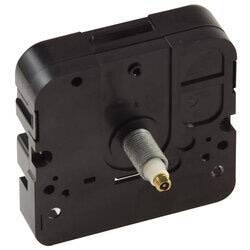
Clock Motors and Getting one of the most from Them
Clock electric motors are what control the performance of traditional timepieces. Modern clock motors ("activities" is the term frequently utilized in the profession) determine their timing from the number of pulses produced by a quartz crystal (at a high and specific resonant regularity) taking place over a specific duration; through counting and neighborhood (in software program) they can after that derive rapid angles of rotation for each of the hands. However, though timekeeping is the most basic capacity of these devices, they can do a lot more, showing attributes varying from customary to exotic to distinctive.
Early clock motors worked mechanically. Possible power in the form of coiled springtimes or hanging weights was converted into the kinetic energy of a turning flywheel, the velocity of which could be controlled with the worked with mix of pendulum and escapement. By gently changing the criteria of this combination (e.g., length of pendulum shaft) the clockmaker was able to accomplish a stable tick at the extremely exact rate of one secondly.
In time the mechanical frameworks were supplanted by digital ones, less burdened with difficult parts. Quartz crystals became the source of power, sending out pulse trains at gradually exact frequencies when voltage is applied to them. Pulse counts could be accumulated in digital signs up, and software program converted the pulse streams right into time pens of hours, mins, and seconds.
Some historical watches displayed dazzling impacts (along with standard timekeeping) that were caused through painstaking and complex style job paired with ingenious mechanical couplings. Such traits can be substitute with the modern electronic clock movements in a reasonably uncomplicated manner through software application. Yet it is also feasible to attain also greater results, just about anything the creative imagination can think up, since programming is a lot more versatile than mechanical engineering.
We have actually all seen watches and other sort of wrist watches prolong regular timekeeping by showing the phase of the moon, the day of the week, or the date of the month. Digital motors do any one of these and a lot more, including 24-hour cycles. Special dials and added hands may be necessary, but the software manages all of it.
For mechanical clocks, weight size, coil tension, and torque needed to revolve the flywheel were all part of the total design. For quartz clocks, motors are designed to handle a variety of clock sizes, but it would be a waste of power to cover the whole range with a single electric motor. Therefore, you will certainly locate conventional motors able to turn hands properly for all clocks up to about 14" in size, and "high-torque" versions for bigger dimensions.
Ticking useds are artifacts of mechanical clock style in that escapements (which controlled pendulum timing) audibly oscillated when a 2nd. But digitally this is no longer essential, and clock electric motors are offered that present a continuous move motion that is likewise quiet.
By setting the activity to operate a cycle of 24 hr plus 50 mins (as opposed to, or in addition to, the 12-hour or 24-hour cycle), it will track the movement of the trend, which can be handy for littoral residents. Likewise offered are movements that track weather condition phenomena, such as temperature level and humidity. In this instance, sensing units are called for to gauge the current worth frequently, and the motor converts it to a (solitary) hand position superimposed over a calibrated dial.
You will discover clock electric motors that supply accessories, many of which mimic heirloom functions. As an example, it could play chime melodies and hour counts, or oscillate a purely aesthetic pendulum.
Abilities of Swiss clockmakers are famous, allowing them to generate outstanding mechanical timekeeping wonders. The modern clockmaker doesn't require the very same degree of skill but he can create digital devices that are equally excellent. It just takes understanding clock electric motors and getting one of the most from them.
Create Your Own Website With Webador